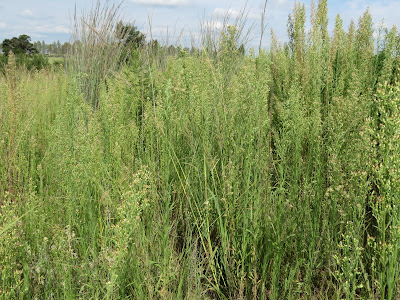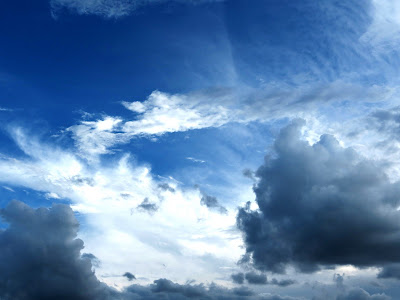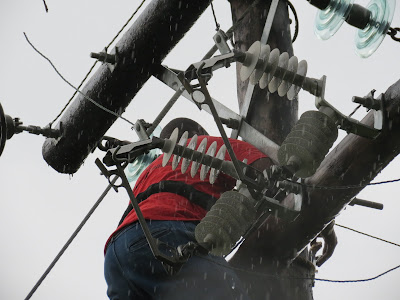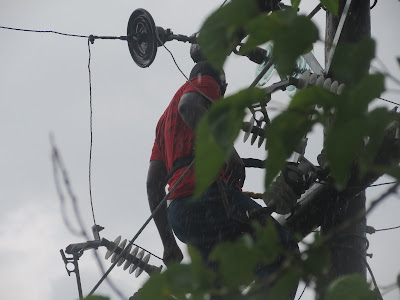Started my afternoon walk in what I now call "The new territory". Good decision as I was immediately rewarded by the sighting of these Spurfowl below.
Swainson's Spurfowl, (Pternistis swainsoni). This Spurfowl stood not more than 15 meters away from me and preened itself, totally unconcerned. It then wandered of into the grass on the verge of the Farm road.
If you look closely in the left hand corner of the photo above you will see it's mate crouched in the long grass. There is a whole family of these birds that live, close to and around the main house and the three cottages here on the farm.
Southern Red Bishop and I, beak to beak! Mano a Mano! He seems to be saying, "if you know what's good for you, you will get that camera out of my face.
Cape Glossy Starling, (Lamprotornis nitens).This photo was taken at an extreme distance and the bird was in full shade, so my ID might not be 100%. You can see the iridescent sheen on it's shoulders in this photo.
A pair of White Throated Swallows enjoying the late afternoon sun, on a willow branch over the water.
The sharp eyes of an African Wattled Lapwing, focuses on some hapless creature.
Monday, 30 January 2012
Crescent moon.
If I thought that my camera was good before these photos, at three different exposures, really blew my socks off!! I never expected such detail. Taken Sunday evening 29th at +- 6:45.
Click on these photos to enlarge and really see the detail.
The photo above taken at the correct setting according to the cameras auto setting.
This photo slightly under exposed.
The last photo slightly over exposed.
Photos taken with a Canon PowerShot SX40HS.
Click on these photos to enlarge and really see the detail.
The photo above taken at the correct setting according to the cameras auto setting.
This photo slightly under exposed.
The last photo slightly over exposed.
Photos taken with a Canon PowerShot SX40HS.
Sunday, 29 January 2012
New territory.
This afternoon I decided to explore a section of the farm that I've never been to before, in the south western corner. The main road from town crosses the N3 highway at this point, and several culverts diverting water from the road to town and from the highway empty into this piece of land. About 7 to 10 acres in extent, it has been allowed to return to nature and is a birders paradise with flocks of birds flying about. The grass and shrubbery is about 2 meters tall and very dense, and difficult to move through.
When the dogs and I were walking towards the farm road that leads to the main road to town and this bit of the farm, Lady refused to follow us and ran back to the cottage with her tail between her legs. All my calling and whistling availed nothing. On returning to the cottage later, I found that she had climbed through the window and was cowering in the lounge. Then it struck me, five years ago I had to take Tombi to the Vet in town. Unbeknownst to me Lady managed to get out of the yard, (she is an escape artist second to none), and ran after the car.
As I turned on to the main road to town I looked into my rear view mirror only to see Lady come tearing off the farm road onto the main road right into the path of a mini bus taxi. Not much the driver could do with his fully laden vehicle, and Lady went tumbling under it. Amazingly, apart from bad bruising and a cut over her right eye she was OK. All these years later that farm road still has bad memories for her.
Click on photos to enlarge.
Female Fan-tailed Widowbird reaching for a seed on a grass stem.
Munching away.
Southern Red bishop feeding on grass seeds.
Full view of a female Fan-tailed Widowbird.
Male Fan-tailed Widowbird, (Euplectes axillaris).Difficult to photograph the males as the don't sit still for long. When they do it's usually low down and difficult to see.
Common Waxbill, (Estrilda astrild)
This Southern Red Bishop with it's feathers all fluffed out. Wether it's trying to scare off rivals or impress the ladies I don't know.
The photo gives an idea of the vegetation on this piece of ground, all head hight or more. I only manage to cover a very small piece of this area so there's lots more birding and photos available here.
When the dogs and I were walking towards the farm road that leads to the main road to town and this bit of the farm, Lady refused to follow us and ran back to the cottage with her tail between her legs. All my calling and whistling availed nothing. On returning to the cottage later, I found that she had climbed through the window and was cowering in the lounge. Then it struck me, five years ago I had to take Tombi to the Vet in town. Unbeknownst to me Lady managed to get out of the yard, (she is an escape artist second to none), and ran after the car.
As I turned on to the main road to town I looked into my rear view mirror only to see Lady come tearing off the farm road onto the main road right into the path of a mini bus taxi. Not much the driver could do with his fully laden vehicle, and Lady went tumbling under it. Amazingly, apart from bad bruising and a cut over her right eye she was OK. All these years later that farm road still has bad memories for her.
Click on photos to enlarge.
Female Fan-tailed Widowbird reaching for a seed on a grass stem.
Munching away.
Southern Red bishop feeding on grass seeds.
Full view of a female Fan-tailed Widowbird.
Male Fan-tailed Widowbird, (Euplectes axillaris).Difficult to photograph the males as the don't sit still for long. When they do it's usually low down and difficult to see.
Common Waxbill, (Estrilda astrild)
This Southern Red Bishop with it's feathers all fluffed out. Wether it's trying to scare off rivals or impress the ladies I don't know.
The photo gives an idea of the vegetation on this piece of ground, all head hight or more. I only manage to cover a very small piece of this area so there's lots more birding and photos available here.
Bull heaven.
After the good rains we had recently, the grass is thick, green and lush, and the cattle grazing on it, fat and sleek.
Nguni cattle are the indigenous cattle of Southern Africa. Long thought of as scrub cattle by commercial farmers they are now gaining ground as a breed. Tough, disease resistant and able to survive the harshest conditions, they thrive where other breeds really struggle.
A few yards away his mate was doing the same. The ladies were grazing all around them. Lush grass, feminine company, what more could a bull ask for?
Pure bred Nguni bull. Photo Nguni Breeders Society.
In the late 19th century the then authorities in South Africa decided to improve the local cattle stocks by importing "better" European breeds. It became illegal to use Nguni bulls to breed with the local cows, and the Nguni breed almost became extinct. In the 1940's the government set up a research commission to investigate the possibility of reviving the breed. By 1994 the breed was recognised as a distinct breed in it's own right.
The colouring of these cattle is extremely diverse with the most beautiful patterns and colours. Some people claim that this is the most beautiful breed of cattle on the planet. I tend to agree with them.
Saturday, 28 January 2012
The flirt.
Sakabula bird is the isiZulu name for the Long Tailed Widow bird. If the Zulus call you a Sakabula they mean that you are a flirt and a show-off. This is exactly what this bird does to attract the ladies.
Long-Tailed Widow Bird, (Euplectes progne). The tail is more than twice the length of the bird. These tail feathers were much sought after for the Zulu warrior's headdresses, back in the days of King Shaka and Dingaan. (c1812 - 1838)
The red and white shoulders can be seen in this photo.
Sakabula bird in flight.
This photo from the Internet.
Long-Tailed Widow Bird, (Euplectes progne). The tail is more than twice the length of the bird. These tail feathers were much sought after for the Zulu warrior's headdresses, back in the days of King Shaka and Dingaan. (c1812 - 1838)
The red and white shoulders can be seen in this photo.
Sakabula bird in flight.
This photo from the Internet.
Friday, 27 January 2012
Proud sparrow.
Took this photo in December. We take sparrows for granted, but they are my favourite bird. Full of self confidence and cheek. Several years ago I put up nesting boxes under the eaves of my cottage and now I have several sparrow families in residence.
Click on photo to enlarge.
Southern Grey-Headed Sparrow. (Passer diffusus).
Put up nesting boxes for your sparrows.
Click on photo to enlarge.
Southern Grey-Headed Sparrow. (Passer diffusus).
Put up nesting boxes for your sparrows.
Mardi Gras.
An excellent post on the origins of Mardi Gras. Long but worth the read.
http://shellysblessings.blogspot.com/2012/01/truth-about-mardi-gras.html?showComment=1327683245261#c1078963908977306919
http://shellysblessings.blogspot.com/2012/01/truth-about-mardi-gras.html?showComment=1327683245261#c1078963908977306919
Thursday, 26 January 2012
Bokmakierie.
Saw all the usual birds on my walk this afternoon, plus two that I have not photographed before. The bird in the first three photos is called a Bokmakierie, this is as a result of it's call, a duet, bok-bok-bok, with a, trrreee, responce.
Bokmakierie, (Telephorus zeylonus) This is a Shrike like bird, that lives of insects, small reptiles, birds, and sometimes fruit.
This bird, a male, seems to be clarring at me for intruding on it's privacy. There was a female but she kept well out of sight in foliage of the thorn tree.
Turned it's back on me to show it's disdain.
The African Wattled Lapwings let me get much closer this afternoon and I got this very clear photo. Click on photo to enlarge.
Last but not least, two female Southern Red Bishop weaver birds, two very demure ladies. The females always fly away at my arrival at the dam, while the males stay protectively at the nests. This afternoon I spotted where these two landed and took this photo. Compare with the male below.
Tuesday, 24 January 2012
Monday, 23 January 2012
African Wattled Lapwing
Decided to take a look at a different part of the farm this afternoon, a small piece of wetland, and came across a small flock of African Wattled Lapwings.
African Wattled Lapwing, (Vanellus senegalus) The yellow wattle, hanging from the base of the beak, (mandible) is obscured by the stem of a plant in this picture.
Here the white crown and the red stripe between the crown and the yellow beak with a black tip, can be seen. The wattle is also visible in this photo.
These photos were taken at extreme range, I found it hard to see the birds with the naked eye and difficult to pick them up in the camera view finder.
This new camera of mine is worth every penny I paid for it.
African Wattled Lapwing, (Vanellus senegalus) The yellow wattle, hanging from the base of the beak, (mandible) is obscured by the stem of a plant in this picture.
The wattle can be seen in this photo. Even though I was very far from them these birds were very wary of me and the dogs.
Here the white crown and the red stripe between the crown and the yellow beak with a black tip, can be seen. The wattle is also visible in this photo.
These photos were taken at extreme range, I found it hard to see the birds with the naked eye and difficult to pick them up in the camera view finder.
This new camera of mine is worth every penny I paid for it.
Sunday, 22 January 2012
The miracle of rain.
After yesterdays rainstorm, we had 60 millimetres +, the whole world was refreshed and green this morning. After church I took the camera and the dogs to see what there was to be seen.
Click on photos to enlarge.
Yesterday this shrub was a grey green dried up thorn bush, this morning it's bright green and lush with bright yellow flowers. Absolutely amazing how quickly nature recovers after a good rainfall.
The little brook on the farm is no longer sneaking sulkily out from under the culvert, but babbling along as a good little brook should.
Even the Southern Red-bishop looks brighter after the rain.
A Black-Headed heron, (Ardea melanocephala) on the look out for breakfast. This picture and the one below need to be enlarged to see the full effect.
A bird on the wing. Haven't ID this bird yet, even has my sister Jo, at memorablemeanders.blogspot.com flummoxed, and she has many years birding experience.
Click on photos to enlarge.
Yesterday this shrub was a grey green dried up thorn bush, this morning it's bright green and lush with bright yellow flowers. Absolutely amazing how quickly nature recovers after a good rainfall.
The little brook on the farm is no longer sneaking sulkily out from under the culvert, but babbling along as a good little brook should.
Even the Southern Red-bishop looks brighter after the rain.
A Black-Headed heron, (Ardea melanocephala) on the look out for breakfast. This picture and the one below need to be enlarged to see the full effect.
A bird on the wing. Haven't ID this bird yet, even has my sister Jo, at memorablemeanders.blogspot.com flummoxed, and she has many years birding experience.
Electrical storm & heavy rain.
Yesterday afternoon we had a severe electrical storm and heavy rain, first rain in almost a month and things were starting to look very dry. During the storm a bolt of lightning struck the high tension wires that run past the cottage, knocking the electricity out.
About 40 minutes later a repair crew arrived and sorted the problem out. The whole process took about an hour and a half as there were three line breaks, where the surge of electricity from the lightning bolt had burnt through the cables.
Linesman climbing the utility pole with special clamps attached to his boots.
The linesman attaching his safety harness above the crosspiece. The break in the power cable can be seen in the top left hand corner of the photo. The cable burnt through before the breaker switch could kick out. The breaker switches can be seen in this photo just behind the linesman.
This happened at three other pylons in a row. Before climbing up the utility pole the linesman and his assistant had isolated this section, further down the line by pulling the breaker switches, which are situated at strategic points along the power line for this purpose.
Inspecting the break. The rain did not seem to bother him in the least. When I asked him why he was not wearing a raincoat he said it just gets in the way while he's climbing and trying to work.
Repairing the break. The new piece of cable needed to repair the problem come pre-prepared, cut to length, and with the necessary fittings needed to attach it to the high tension cable. Took this photo through my lounge window.
These repair crews are on call 24/7 and 365 days of the year, day and night in all weather. A tough job and they do it well.
About 40 minutes later a repair crew arrived and sorted the problem out. The whole process took about an hour and a half as there were three line breaks, where the surge of electricity from the lightning bolt had burnt through the cables.
Linesman climbing the utility pole with special clamps attached to his boots.
The linesman attaching his safety harness above the crosspiece. The break in the power cable can be seen in the top left hand corner of the photo. The cable burnt through before the breaker switch could kick out. The breaker switches can be seen in this photo just behind the linesman.
This happened at three other pylons in a row. Before climbing up the utility pole the linesman and his assistant had isolated this section, further down the line by pulling the breaker switches, which are situated at strategic points along the power line for this purpose.
Inspecting the break. The rain did not seem to bother him in the least. When I asked him why he was not wearing a raincoat he said it just gets in the way while he's climbing and trying to work.
Repairing the break. The new piece of cable needed to repair the problem come pre-prepared, cut to length, and with the necessary fittings needed to attach it to the high tension cable. Took this photo through my lounge window.
These repair crews are on call 24/7 and 365 days of the year, day and night in all weather. A tough job and they do it well.
Saturday, 21 January 2012
School.
School started for the new academic year on the 9th. of January for teachers and the learners arrived on the 11th. I did not see the learners until 16th. The first week of school is just too busy with the issuing of text and excersise books, and various administrative tasks to be completed, class lists, class registers, etc.
This grade 5 class has been coming to me for 4 years now. First lesson of the year how to care for books.
Grade one's in the library for their first story time. They had more stories to tell me than I had to tell them. About new baby brothers, puppies, kittens, you name it they all had something to tell me.
This grade one class, still very enthralled by the idea of school and learning. How long before the system squashes that enthusiasm?
Friday, 20 January 2012
Bird bedtime.
Took my evening walk with the dogs a bit later than usual, just in time to watch all the birds heading home to bed.
Click on photo to enlarge.
Black-headed herons. This photo was almost shot from the hip. Amazing how fast these birds are moving, when you are trying track them in your camera view finder.
White-throated swallows on their spiky roost, settling down for the night.
Click on photo to enlarge.
Black-headed herons. This photo was almost shot from the hip. Amazing how fast these birds are moving, when you are trying track them in your camera view finder.
White-throated swallows on their spiky roost, settling down for the night.
Wednesday, 18 January 2012
Contented, happy dogs.
Nothing my dogs love more than going for a walk, and swimming in the three different ponds on our route.
Sissy always charges the water as if it might escape before she gets in. In the process she always gets water in her ears. Sometimes she gets in too deep and does her floating brick impersonation with just her tail sticking out like a periscope. Either way, back home Dad has to massage the water out of the convoluted Daschhund ear channels, while she lies on her side groaning with doggy pleasure.
Lady is a born water dog, never misses a chance for a swim with at least four dips on a typical afternoon walk. Winter water temperatures of 7 or 8 degrees Celsius are just as good as summer temperatures of 24 degrees Celsius.
The look seems to say, "Not another photo!"
Mother and daughter investigating a very interesting smell.
Sissy always charges the water as if it might escape before she gets in. In the process she always gets water in her ears. Sometimes she gets in too deep and does her floating brick impersonation with just her tail sticking out like a periscope. Either way, back home Dad has to massage the water out of the convoluted Daschhund ear channels, while she lies on her side groaning with doggy pleasure.
Lady is a born water dog, never misses a chance for a swim with at least four dips on a typical afternoon walk. Winter water temperatures of 7 or 8 degrees Celsius are just as good as summer temperatures of 24 degrees Celsius.
The look seems to say, "Not another photo!"
Mother and daughter investigating a very interesting smell.
Subscribe to:
Posts (Atom)




















































